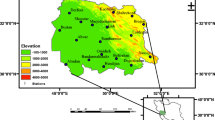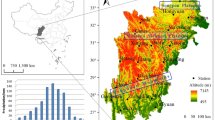Abstract
Disaster weather forecasting is becoming increasingly important. In this paper, the trajectories of Mesoscale Convective Systems (MCSs) were automatically tracked over the Chinese Tibetan Plateau using Geostationary Meteorological Satellite (GMS) brightness temperature (Tbb) from June to August 1998, and the MCSs are classified according to their movement direction. Based on these, spatial data mining methods are used to study the relationships between MCSs trajectories and their environmental physical field values. Results indicate that at 400hPa level, the trajectories of MCSs moving across the 105°E boundary are less influenced by water vapor flux divergence, vertical wind velocity, relative humidity and K index. In addition, if the gravity central longitude locations of MCSs are between 104°E and 105°E, then geopotential height and wind divergence are two main factors in movement causation. On the other hand, at 500hPa level, the trajectories of MCSs in a north-east direction are mainly influenced by K index and water vapor flux divergence when their central locations are less than 104°E. However, the MCSs moving in an east and south-east direction are influenced by a few correlation factors at this level.
Similar content being viewed by others
References
ARNAUD Y, DESBOIS M, MAIZI J, 1992. Automatic tracking and characterization of African convective systems on meteosat pictures[J]. Journal of Applied Meteorology, 31: 443–453.
BREIMAN L, FRIEDMAN J H, OLSHEN R A, et al., 1984. Classification and Regression Trees [M]. Monterey, CA: Wadsworth International Group.
CARVALHO L M V, JONES C, 2001. A satellite method to identify structural properties of mesoscale convective systems based on maximum spatial correlation tracking technique (MASCOTTE)[J]. Journal of Applied Meteorology, 40: 1683–1701.
HOLDER L B, 1995. Intermediate decision trees[A]. In: Proc. 14th Intl. Joint Conf. on Artificial Intelligence(AAAI’1995) [C]. Montreal: Morgan Kaufmann, 1056–1062.
JIANG Ji-xi, FAN Mei-zhu, 2002. Convective clouds and mesoscale systems over the Tibetan Plateau in summer [J]. Journal of Atmospheric Sciences, 26(2): 263–270. (in Chinese)
KITAMOTO A, 2002. Spatial-temporal data mining for typhoon image collection[J]. Journal of Intelligence Information Systems, 19(1): 25–41.
KOPERSKI K, HAN J, 1995. Discovery of spatial association rules in geographic information databases[A]. In: Proc. 4th Intl. Symposium on large Spatial Databases (SSD’95)[C]. Maine: Springer, 47–66.
LEE R S T, LIU J N K, 1999. An automatic satellite interpretation of tropical cyclone patterns using elastic graph dynamic link model[J]. IJPRAI, 13: 1251–1270.
LEE R S T, LIU J N K, 2000. ATMOSPHERE—Automatic track mining and objective satellite pattern hunting system using enhanced RBF and EGDLM [A]. In Proceedings of 17th National Conference on Artificial Intelligence (AAAI’2000) [C]. Austin: AAAI Press, 603–608.
MACHADO L A T, ROSSOW W B, GUEDES R L et al., 1998. Life cycle variations of mesoscale convective systems over the America [J]. Mon. Wea. Rev., 126: 1630–1654.
MADDOX R A, 1980. Mesoscale convective complexes [J]. Bull. Amer. Meteor. Soc., 61: 1374–1387.
SALVATORE Ruggieri, 2002. Efficient C4.5 [J]. IEEE Transactions on Knowledge and Data Engineering, 14(2): 438–444.
SHAN Yin, LIN Hui, FU Wei-ci, et al., 2003. The features of MCS during its initiation over Tibetan Plateau in summer [J]. Journal of Tropical Meteorology, 19: 61–66. (in Chinese)
WEISS S M, KAPOULEAS I, 1989. An empirical comparison of pattern recognition, neural nets, and machine learning classification methods[A]. In: Proc. 11th Intl. Joint Conf. on Artificial Intelligence (IJCAI’89) [C]. Detroit: Morgan Kaufmann, 781–787.
ZHOU Zhi-hua, CHEN Shi-fu, CHEN Zhao-qiao, 1999. Mining typhoon knowledge with neural networks[A]. In: Proc. 11th IEEE Int. Conf. on Tools with Artificial Intelligence (ICTAI’99) [C]. Los Alamitos: IEEE Computer Society, 325–326.
Author information
Authors and Affiliations
Additional information
Foundation item: Under the auspices of the National Natural Science Foundation of China (No. 40371080), Key Foundation Supported by Ministry of Education (No. 104083), Foundation of Wuhan University State Key Laboratory of Information Engineering in surveying, mapping and remote sensing (No. WKL (03) 0103)
Biography: GUO Zhong-yang (1965-), male, a native of Shengxian of Zhejiang Province, professor, specialized in spatial data mining. E-mail: zyguo@geo.ecnu.edu.cn
Rights and permissions
About this article
Cite this article
Guo, Zy., Dai, Xy., Jian-ping, W. et al. Image analysis of geostationary meteorological satellite for monitoring movement of mesoscale convective systems over Tibetan plateau. Chin. Geograph.Sc. 15, 231–237 (2005). https://doi.org/10.1007/s11769-005-0035-5
Received:
Issue Date:
DOI: https://doi.org/10.1007/s11769-005-0035-5




